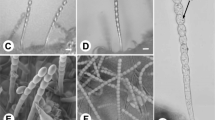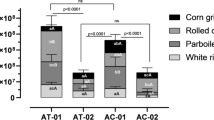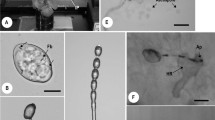Abstract
Using an electrostatic rotational spore collector, we consecutively collected all of the conidia produced from single colonies of melon powdery mildew (Podosphaera xanthii Pollacci KMP-6 N) on leaves of living melon plants throughout the lifetime of the colony in a natural environment, and counted all conidia that were attracted to insulators. The collector consisted of an insulated round plastic container, a conductor (copper) film, an insulator (collector) film, an electrostatic voltage generator and a timer mechanism. Negative charge was supplied from the voltage generator to the conductor film, and the negatively charged conductor film caused dielectric polarization of the insulator film. The insulator film, which creates an attractive force for trapping conidia that enter the field, was placed ca. 2 cm from the apex of the single colony. Released conidia were successfully attracted to the electrostatically activated insulator films. Each collector film was exchanged for a new insulator film at 24 h intervals until KMP-6 N ceased to release conidia from single colonies. During a colony’s lifespan, KMP-6 N released an average of 12.6 × 104 conidia from each of the single colonies at ca. 744 h. Additionally, we found that 1) the number of conidia released from single colonies in daytime was larger than that in night-time, 2) conidia were released from single colonies for ca. 2–4 h longer in spring or summer than in autumn or winter, and 3) release of conidia from KMP-6 N decreased as light intensity declined. Thus, conidial release from conidiophores is affected by day-length and light intensity.






Similar content being viewed by others
References
Aylor DE (1990) The role of intermittent wind in the dispersal of fungal pathogens. Annu Rev Phytopathol 28:73–92
Braun U (1987) A monograph of the Erysiphales (powdery mildews). Beih Nova Hedwig 89:1–700
Braun U, Cook RTA (2012) Taxonomic manual of the Erysiphales (powdery mildews). CBS-KNAW Fungal Biodiversity Centre, The Netherlands
Braun U, Shishkoff N, Takamatsu S (2001) Phylogeny of Podosphaera sect. Sphaerotheca subsect. Magnicellulatae (Sphaerotheca fuliginea auct. s. Lat.) inferred from rDNA ITS sequences – a taxonomic interpretation. Schlechtendalia 7:45–52
Brown JKM, Hovmøller MS (2002) Aerial dispersal of pathogens on the global and continental scales and its impact on plant disease. Science 297:537–541
Chen R-S, Chu C, Cheng C-W, Chen W-Y, Tsay J-G (2008) Differentiation of two powdery mildews of sunflower (Helianthus annuus) by a PCR-mediated method based on ITS sequences. Eur J Pl Path 121:1–8
Cosme B-R, Josefina L-F, Raúl A-M, María Dolores M-R, José Armando C-F, José Benigno V-T, Fabiola Sary Mell L-S, Raymundo Saúl G-E (2012) Characterization of powdery mildew in cucumber plants under greenhouse conditions in the Culiacan Valley, Sinaloa, Mexico. Afr J Agric Res 7:3237–3248
Del Pino D, Olalla L, Pérez-García A, Rivera ME, García S, Moreno R, Torés JA (2002) Occurrence of races and pathotypes of cucurbit powdery mildew in southeastern Spain. Phytoparasitica 30:459–466
Griffith WT (2004) Electrostatic phenomena. In: Bruflodt D, Loehr BS (eds) The physics of everyday phenomena: a conceptual introduction to physics. McGraw-Hill, New York, pp 232–252
Halliday D, Resnick R, Walker J (2005) Electric charge. In: Johnson S, Ford E (eds) Fundamentals of physics. John Wiley & Sons, New York, pp 561–579
Hirata K (1967) Notes on haustoria, hyphae and conidia of the powdery mildew fungus of barley, Erysiphe graminis f. Sp. hordei. Mem Fac Agric. Nigata Univ 6:205–259
Hirata T, Cunnington JH, Paksiri U, Limkaisang S, Shishkoff N, Grigailiunaite B, Sato Y, Takamatsu S (2000) Evolutionary analysis of subsection Magnicellulatae of Podosphaera section Sphaerotheca (Erysiphales) based on the rDNA internal transcribed spacer sequences with special reference to host plants. Can J Bot 78:1521–1530
Hong Y-J, Hossain MR, Kim H-T, Park J-I, Nou I-S (2018) Identification of two new races of Podosphaera xanthii causing powdery mildew in melon in South Korea. Plant Pathol J 34:182–190
Hosoya K, Narisawa K, Pitrat M, Ezura H (1999) Race identification in powdery mildew (Sphaerotheca fuliginea) on melon (Cucumis melo) in Japan. Plant Breed 118:259–262
Křístková E, Lebeda A, Sedláková B (2004) Virulence of Czech cucurbit powdery mildew isolates on Cucumis melo genotypes MR-1 and PI 124112. Sci Hortic 99:257–265
Křístková E, Lebeda A, Sedláková B (2009) Species spectra, distribution and host range of cucurbit powdery mildews in the Czech Republic, and in some other European and middle eastern countries. Phytoparasitica 37:337–350
Leach CM (1976) An electrostatic theory to explain violent spore liberation by Drechslera turcica and other fungi. Mycologia 68:63–86
Matsuda Y, Ikeda H, Moriura N, Tanaka N, Shimizu K, Oichi W, Nonomura T, Kakutani K, Kusakari S, Higashi K, Toyoda H (2006) A new spore precipitator with polarized dielectric insulators for physical control of tomato powdery mildew. Phytopathology 96:967–974
McGrath MT, Thomas CE (1996) Powdery mildew. In: Hopkins DL, Thomas CE (eds) Zitter TA. Compendium of cucurbit disease. The American Phytopathological Society Press, St. Paul, Minnesota, pp 28–30
Mizuno A, Washizu M (1995) Biomedical engineering. In: Chang JS, Kelley AJ, Crowley JM (eds) Handbook of electrostatic processes. Marcel Dekker, New York, pp 653–686
Mohamed YF, Bardin M, Nicot PC, Pitrat M (1995) Causal agents of powdery mildew of cucurbits in Sudan. Plant Dis 79:634–636
Moriura N, Matsuda Y, Oichi W, Nakashima S, Hirai T, Nonomura T, Kakutani K, Kusakari S, Higashi K, Toyoda H (2006a) An apparatus for collecting total conidia of Blumeria graminis f. Sp. hordei from leaf colonies using electrostatic attraction. Plant Pathol 55:367–374
Moriura N, Matsuda Y, Oichi W, Nakashima S, Hirai T, Sameshima T, Nonomura T, Kakutani K, Kusakari S, Higashi K, Toyoda H (2006b) Consecutive monitoring of lifelong production of conidia by individual conidiophores of Blumeria graminis f. Sp. hordei on barley leaves by digital microscopic techniques with electrostatic micromanipulation. Mycol Res 110:18–27
Nonomura T, Matsuda Y, Xu L, Kakutani K, Takikawa Y, Toyoda H (2009) Collection of highly germinative pseudochain conidia of Oidium neolycopersici from conidiophores by electrostatic attraction. Mycol Res 113:364–372
Nonomura T, Matsuda Y, Yamashita S, Akahoshi H, Takikawa Y, Kakutani K, Toyoda H (2013) Natural woody plant, Mallotus japonicus, as an ecological partner to transfer different pathotypic conidia of Oidium neolycopersici to greenhouse tomatoes. Plant Prot Sci 49:S33–S40
Oichi W, Matsuda Y, Sameshima T, Nonomura T, Kakutani K, Nishimura H, Kusakari S, Toyoda H (2004) Consecutive monitoring for conidiogenesis by Oidium neolycopersici on tomato leaves with a high-fidelity digital microscope. J Gen Plant Pathol 70:329–332
Oichi W, Matsuda Y, Nonomura T, Toyoda H, Xu L, Kusakari S (2006) Formation of conidial pseudochains by tomato powdery mildew Oidium neolycopersici. Plant Dis 90:915–919
Pérez-García A, Romero D, Fernández-Ortuño D, López-Ruiz F, De Vicente A, Torés JA (2009) The powdery mildew fungus Podosphaera fusca (synonym Podosphaera xanthii), a constant threat to cucurbits. Mol Plant Pathol 10:153–160
Reifschneider FJB, Boiteux LS, Occhiena EM (1985) Powdery mildew on melon (Cucumis melo) caused by Sphaerotheca fuliginea in Brazil. Plant Dis 69:1069–1070
Sameshima T, Kashimoto K, Kida K, Matsuda Y, Nonomura T, Kakutani K, Nakata K, Kusakari S, Toyoda H (2004) Cytological events in tomato leaves inoculated with conidia of Blumeria graminis f. Sp. hordei and Oidium neolycopersici KTP-01. J Gen Plant Pathol 70:7–10
Shimizu T, Matsuda Y, Nonomura T, Ikeda H, Tamura N, Kusakari S, Kimbara J, Toyoda H (2007) Dual protection of hydroponic tomatoes from rhizosphere pathogens Ralstonia solanacearum and Fusarium oxysporum f. Sp. radicis-lycopersici and airborne conidia of Oidium neolycopersici with an ozone-generative electrostatic spore precipitator. Plant Pathol 56:987–997
Sowell G Jr (1982) Population shift of Sphaerotheca fuliginea on musk melon. J Am Soc Hortic Sci 112:156–160
Suzuki T, Nishimura S, Yagi K, Nakamura R, Takikawa Y, Matsuda Y, Kakutani K, Nonomura T (2018) Effects of light quality on conidiophore formation of the melon powdery mildew pathogen Podosphaera xanthii. Phytoparasitica 94:1105–1110
Takikawa Y, Kakutani K, Nonomura T, Matsuda Y, Toyoda H (2011) Conidia of Erysiphe trifoliorum attempt penetration twice during a two-step germination process on non-host barley leaves and an artificial hydrophobic surface. Mycoscience 52:204–209
Takikawa Y, Nonomura T, Miyamoto S, Okamoto N, Murakami T, Matsuda Y, Kakutani K, Kusakari S, Toyoda H (2015) Digital microscopic analysis of developmental process of conidiogenesis by powdery mildew pathogens isolated from melon leaves. Phytoparasitica 43:517–530
Tomason Y, Gibson PT (2006) Fungal characteristics and varietal reactions of powdery mildew species on cucurbits in steppes of Ukraine. Agron Res 4:549–562
Acknowledgements
This work was partly supported by Grants for Scientific Research from Faculty of Agriculture, Kindai University, and Research Institute for Agricultural Technology and Innovation, Kindai University. The authors acknowledge the assistance of two professional editors who assisted with the English and grammar.
Author information
Authors and Affiliations
Corresponding author
Ethics declarations
Conflict of interest
The authors declare that they have no conflict of interest.
Additional information
Publisher’s note
Springer Nature remains neutral with regard to jurisdictional claims in published maps and institutional affiliations.
Rights and permissions
About this article
Cite this article
Suzuki, T., Nakamura, R., Takagi, N. et al. Quantitative analysis of the lifelong production of conidia released from single colonies of Podosphaera xanthii on melon leaves using electrostatic techniques. Australasian Plant Pathol. 48, 297–307 (2019). https://doi.org/10.1007/s13313-019-00629-z
Received:
Accepted:
Published:
Issue Date:
DOI: https://doi.org/10.1007/s13313-019-00629-z




